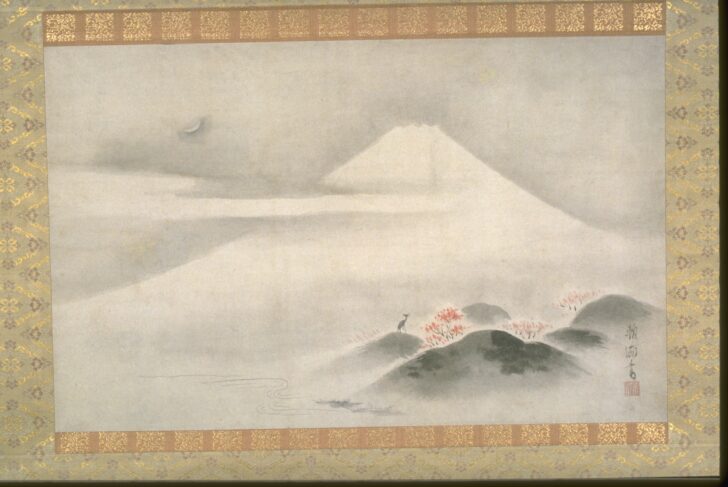Mt. Fuji in Autumn
Hanabusa Itchō

Description
Hanabusa Itchō
Japan, 1652–1724
Mt. Fuji in Autumn
Edo period (1615–1868)
Early 18th century
Hanging scroll, ink and light color on paper
Gift of Mr. Harold Phillip Stern for the
James Marshall Plumer Memorial Collection, 1963/2.59
Like Sakai Hōitsu (whose painting of Mount Fuji is also on
display in this gallery), Itchō trained in the prestigious Kanō
School style of painting endorsed by the ruling military
class, though he later departed from its conventions to
produce works that reflected the aesthetic sensibilities of
the literati (professional and amateur artists who modeled
themselves after Chinese scholar-artists) and scenes of
everyday life in the capital city of Edo (present-day Tokyo).
In this melancholy image a lone male deer stands among
red autumn leaves in a scene dimly lit by a crescent moon.
It is likely that Itchō produced this image with a celebrated
eighth-century poem by Sarumaru in mind, though he
located the scene in the mountains visible from Edo,
including Mount Fuji:
When I hear the voice
of the stag crying for his mate
stepping through the fallen leaves
deep in the mountains—then is the time that autumn is saddest.
(translation by Joshua S. Mostow)
Subject Matter:
The volcanic Mount Fuji was considered a sacred mountain and was visited mostly by pilgrims until the eighteenth century, when more tourists made their way to, and often up, the mountain. Visible from Edo (modern-day Tokyo), the awe-inspiring Fuji was gradually adopted as a symbol of civic pride by its residents. Popular print designers such as Katsushika Hokusai (whose work featuring Mt. Fuji is also on view in this gallery) exploited the affection for the mountain in their art.
Here, the painter Hanabusa Itchô combines an almost iconic view of Fuji with classical poetic emblems of late autumn—a crescent moon, a lone male deer, and red autumn leaves— to create a scene of quiet melancholy.
In this melancholy image, a lone male deer stands among red autumn leaves in a scene dimly lit by a crescent moon. It is likely that Itchō produced this image with a celebrated eighth-century poem by Sarumaru in mind, though he located the scene in the mountains visible from Edo, including Mount Fuji:
When I hear the voice
of the stag crying for his mate
stepping through the fallen leaves
deep in the mountains—then is the time that autumn is saddest.
(translation by Joshua S. Mostow)
Physical Description:
In the center of this painting, there is Mt. Fuji. Next to the peak of the mountain, to the left of the painting, there is a crescent moon and clouds. To the bottom right of the painting, there are green hills with trees that have red fall leaves on them. Next to these trees, there is one lone deer looking up to the sky. At the bottom of the Mountain, there is a river.
Usage Rights:
If you are interested in using an image for a publication, please visit https://umma.umich.edu/request-image/ for more information and to fill out the online Image Rights and Reproductions Request Form.